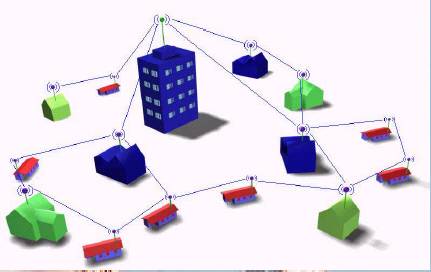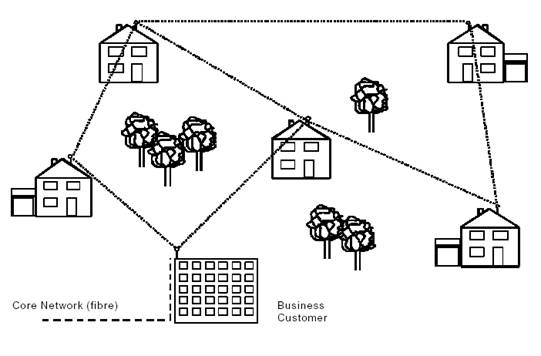





Published on Feb 14, 2025
Governments are keen to encourage the roll-out of broadband interactive multimedia services to business and residential customers because they recognise the economic benefits of e-commerce, information and entertainment.
Digital cable networks can provide a compelling combination of simultaneous services including broadcast TV, VOD, fast Internet and telephony. Residential customers are likely to be increasingly attracted to these bundles as the cost can be lower than for separate provision. Cable networks have therefore been implemented or upgraded to digital in many urban areas in the developed countries.
ADSL has been developed by telcos to allow on-demand delivery via copper pairs. A bundle comparable to cable can be provided if ADSL is combined with PSTN telephony and satellite or terrestrial broadcast TV services but incumbant telcos have been slow to roll it out and 'unbundling' has not proved successful so far. Some telcos have been accused of restricting ADSL performance and keeping prices high to protect their existing business revenues. Prices have recently fallen but even now the ADSL (and SDSL) offerings are primarily targeted at provision of fast (but contended) Internet services for SME and SOHO customers. This slow progress (which is partly due to the unfavourable economic climate) has also allowed cable companies to move slowly.
A significant proportion of customers in suburban and semi-rural areas will only be able to have ADSL at lower rates because of the attenuation caused by the longer copper drops. One solution is to take fibre out to street cabinets equipped for VDSL but this is expensive, even where ducts are already available.
Network operators and service providers are increasingly beset by a wave of technologies that could potentially close the gap between their fibre trunk networks and a client base that is all too anxious for the industry to accelerate the rollout of broadband. While the established vendors of copper-based DSL and fibre-based cable are finding new business, many start-up operators, discouraged by the high cost of entry into wired markets, have been looking to evolving wireless radio and laser options.
One relatively late entrant into this competitive mire is mesh radio, a technology that has quietly emerged to become a potential holder of the title 'next big thing'. Mesh Radio is a new approach to Broadband Fixed Wireless Access (BFWA) that avoids the limitations of point to multi-point delivery. It could provide a cheaper '3rd Way' to implement residential broadband that is also independent of any existing network operator or service provider.
Instead of connecting each subscriber individually to a central provider, each is linked to several other subscribers nearby by low-power radio transmitters; these in turn are connected to others, forming a network, or mesh, of radio interconnections that at some point links back to the central transmitter.

Fig.2.3
Mesh topology networks, sometimes referred to as peer-to-peer or multipoint-to-multipoint, offer significant benefits over PtP and PtMP topologies. In addition to being the most flexible broadband wireless topology, mesh technology: (1) enables network expansion; (2) provides a self-healing architecture; (3) reduces implementation and operating costs; and (4) facilitates mobile applications.
Often, it simply isn't possible for each building to have LOS with each and every other building. In urban corridors, large buildings can create network shadows blocking the radio signal from its intended target. This may make it difficult, or at least economically impractical, to reach every building within the organization using the company's new high-speed wireless network. In a suburban or rural setting, hills, trees, and other obstructions may have a similar effect, causing signal attenuation or complete blockage, greatly mitigating the potential benefits of a broadband wireless network.
A wireless mesh can be re-configured on the fly to account for certain conditions, and also allow for reconfiguration in the event that a given node fails or moves out of range of all other nodes. On the other hand, it’s also possible to pre-configure an unchanging wireless mesh, in which case it behaves just like most wired networks – the connections between nodes are fixed. We usually call the former case “self organizing”, and the latter “static”. Self-organizing networks usually include the ability to add new nodes on the fly.
In general, there are two general types of processing elements in a network: infrastructure nodes, which move data to and from clients, and client nodes, which consume or produce traffic across the network. A given node can be one or the other, or both at once, in which case we call it a hybrid. Note that a hybrid configuration introduces a number of challenges. Note also that an infrastructure mesh might be static, which its corresponding client mesh might be self-organizing - lots of configurations are possible to meet application, cost, and other constraints.
Since wireless meshes are based on radio links, mobility is a real possibility. But, of course, fixed configurations can also be built. Note that even in a fixed mesh configuration, many possible paths can exist in the network between any two given nodes. So just because the physical network itself doesn’t (or rarely) changes doesn’t mean that any flexibility is lost. The Internet is, after all, a fixed wired mesh!

Mesh Radio has a flexible architecture. It is based on Mesh networking or multi-hop networking for moving data efficiently between devices. In a traditional wireless LAN, multiple clients access the network through a direct wireless link to an access point (AP); this is a "single-hop" network. In a multi-hop network, any device with a radio link can serve as a router or AP. If the nearest AP is congested, data is routed to the closest low-traffic node. Data continues to "hop" from one node to the next in this manner, until it reaches its final destination.
Mesh Radio technique has been pioneered by Radiant Networks, based near Cambridge and Caly Networks in Sunnyvale, California. The architecture of Radiant’s Mesh Radio solution is shown in figure
| Are you interested in this topic.Then mail to us immediately to get the full report.
email :- contactv2@gmail.com |